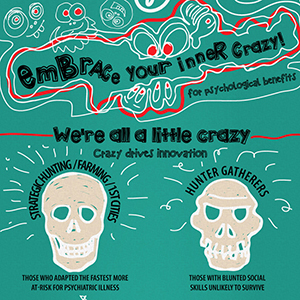We’re all a little crazy:
Crazy drives innovation:
1.) Hunter Gatherers
2.)Strategic hunting, farming, first cities
=those with blunted social skills unlikely to survive.
=those who adapted the fastest and most at risk for psychiatric illness.
Innovations and abnormalities:
1.) Empathy and Ability to read faces[1]
1a.) Over analysis of social cues: social anxiety
2.) Ability to think about the future and plan
2a.) Obsessive disorders
3.) Ability to think about unattainable goals
3a.) Depression helps us detach from unworthy goals.
4.) Being on a ‘high’ leads to more sex and collaboration.
4a.) Bi-polarism can be harmful.
Good thing there are safe ways to use crazy
Risk taking = creativity
Your shadow: an exercise
A day without consequences:
eat without gaining weight
have an affair without complications
murder someone and they come back to life
Now have a conversation with that “person,” your shadow.
Create new stories, don’t tell yourself the same things over and over[6]
Using new language and conceptual sets triggers a physiological response.
New Experiences take us outside of our previous categories and habits.
Old experiences are already reinforced with old categories and habits.
Step out of the box and make new emotion filled experiences.
You remember more when they’re emotional.
And move a bit closer to these high achievers (not too close, they were crazy): [2][3][4][5]
Michelangelo: Autism/forgot very routine self maintenance. Oftentimes when he would remember to take his shoes off, his skin would peel off with them.
Tesla: OCD/Germaphobe, wouldn’t touch round objects. Completed routine tasks three times before continuing.
Van Gogh: Epilepsy, potentially hypergraphia, a condition linked to epilepsy, mania, and an overwhelming urge to write. Cut off ear, committed suicide.
Howard Hughes: Germaphobe, extreme recluse in stress, OCD.
Beethoven: Probably bi-polar. Extreme prolific periods of creation (mania) followed by extreme depression.
Sir Isaac Newton: Thought to be bi-polar and a schizophrenic. Bouts of psychosis, impossible to get along with, and drastic mood swings.
Darwin: Agoraphobia, including visual hallucinations, hysterical crying, and nausea kept him bedridden for almost all of his famous journey on the Beagle.
Dostoyevsky: Epilepsy, and extreme neurosis, which he suffered from are analyzed in many of his works.
Citations:
- http://www.livescience.com/5082-insane.html
- http://www.cracked.com/article_16559_7-eccentric-geniuses-who-were-clearly-just-insane_p2.html
- http://listverse.com/2012/11/03/top-10-crazy-men/
- http://mentalfloss.com/article/12500/11-historical-geniuses-and-their-possible-mental-disorders
- http://neurophilosophy.wordpress.com/2007/04/16/diagnosing-dostoyevskys-epilepsy/
- https://www.alternet.org/2020/01/how-to-use-habit-science-to-help-you-keep-your-new-years-resolutions/
- https://www.psychologytoday.com/us/collections/200910/letting-loose





